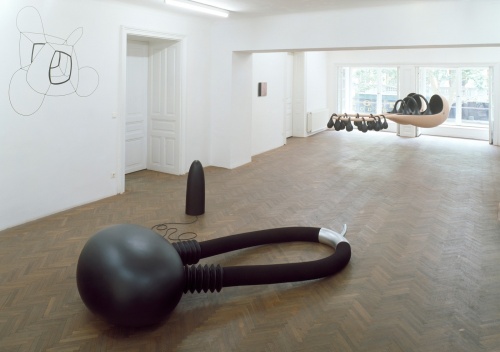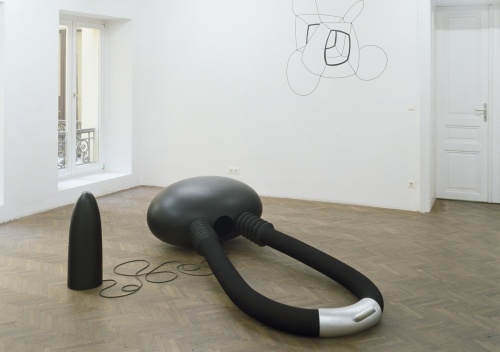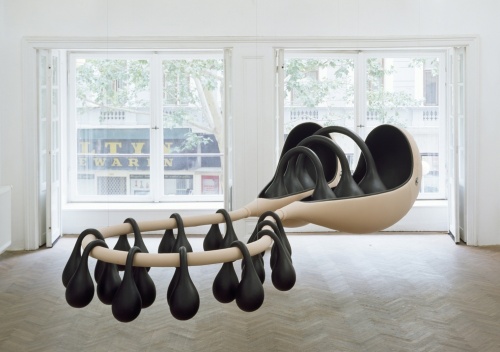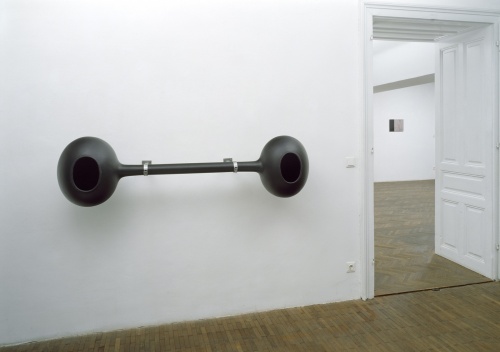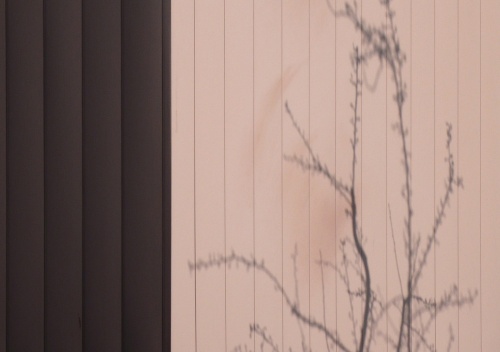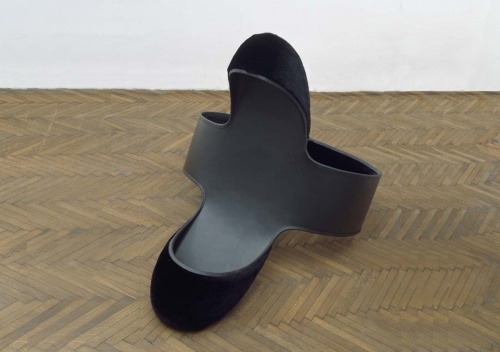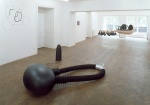 pooped (left), shelter (right), Projektraum Viktor Bucher, Vienna 2007
pooped (left), shelter (right), Projektraum Viktor Bucher, Vienna 2007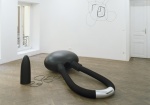 pooped, 2006; fibre glass, foam rubber, aluminium, textile; 60 x 110 x 280 cm
pooped, 2006; fibre glass, foam rubber, aluminium, textile; 60 x 110 x 280 cm
Photo: Franz Schachinger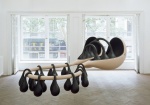 shelter, 2006; fibre-glass, aluminium, foam rubber, textile; 80 x 320 x 140 cm
shelter, 2006; fibre-glass, aluminium, foam rubber, textile; 80 x 320 x 140 cm
Courtesy: Collection Liaunig; photo: Franz Schachinger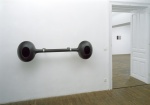 dumb-bell, 2007; fibre-glass, plush, metal; 48 x 174 x 42 cm
dumb-bell, 2007; fibre-glass, plush, metal; 48 x 174 x 42 cm
Photo: Franz Schachinger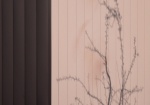 O.T., 2006; lambda print on PVC; 60 x 80 cm
O.T., 2006; lambda print on PVC; 60 x 80 cm
Photo: Franz Schachinger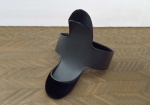 bound slippers, 2007; fibre glass, plush; 100 x 90 x 120 cm
bound slippers, 2007; fibre glass, plush; 100 x 90 x 120 cm
Photo: Franz Schachinger
Home sweet home
, Projektraum Viktor Bucher, Vienna 2007
Home Sweet Home – The Irony of Feelings
Walter Seidl
…
One part of Hayward’s works refers to elements of a domestic setting, correlating with definitions of home, what is familiar, intimate, even if the artist gives these words a disturbing twist. This is also true for the objects in the exhibition “home sweet home” as well as for Home on Legs. Some objects recall cradles, chandeliers or children’s legs, and this is even more explicit in the title of the piece Bound Slippers. The latter refers to the Japanese tradition of bondage, with fiberglass and a plush object resembling ballet shoes. To be bound to “home” evokes culture-specific rites and a differentiation between the private realm and public life. The potential impact of Hayward’s works is, however, much broader and not primarily geared to the reality of a specific everyday life, meaning that uncanny aspects can be found throughout her entire oeuvre. The question that arises in media history has to do with the discrepancy between the represented and the imagined. How objective can things actually appear in a world in which reality and objectivity are simulated in the media and ultimately based on constructed aspects of reality, to which one is expected to keep a critical distance? The unfathomability that appears in Hayward’s sculptures, which has an unsettling effect on the viewer, is complemented, in Freudian style, with a psychological parallel level in which the uncanny is connected with everyday feelings, resurfacing in a humorous way in an artistically mediated formal idiom. The lightness of space is brought into harmony with the seeming lightness of objects. Fusions of various materials that are perfectly executed allow Hayward’s objects that often seem to float in the space to become cosmonautic, almost utopian formations. Amorphous structures whose plasticity extends throughout the space, reveal a hard outer shell which is sometimes clad with synthetic leather or with materials recalling orthophedic aids, while on the inside they are cushioned with plush. Colours that resemble skin or orthopedic aids also alternate with a hard black, so that there is a positive-negative effect referring to the psychological depths of what is being shown here
…
show entire text
Walter Seidl
…
One part of Hayward’s works refers to elements of a domestic setting, correlating with definitions of home, what is familiar, intimate, even if the artist gives these words a disturbing twist. This is also true for the objects in the exhibition “home sweet home” as well as for Home on Legs. Some objects recall cradles, chandeliers or children’s legs, and this is even more explicit in the title of the piece Bound Slippers. The latter refers to the Japanese tradition of bondage, with fiberglass and a plush object resembling ballet shoes. To be bound to “home” evokes culture-specific rites and a differentiation between the private realm and public life. The potential impact of Hayward’s works is, however, much broader and not primarily geared to the reality of a specific everyday life, meaning that uncanny aspects can be found throughout her entire oeuvre. The question that arises in media history has to do with the discrepancy between the represented and the imagined. How objective can things actually appear in a world in which reality and objectivity are simulated in the media and ultimately based on constructed aspects of reality, to which one is expected to keep a critical distance? The unfathomability that appears in Hayward’s sculptures, which has an unsettling effect on the viewer, is complemented, in Freudian style, with a psychological parallel level in which the uncanny is connected with everyday feelings, resurfacing in a humorous way in an artistically mediated formal idiom. The lightness of space is brought into harmony with the seeming lightness of objects. Fusions of various materials that are perfectly executed allow Hayward’s objects that often seem to float in the space to become cosmonautic, almost utopian formations. Amorphous structures whose plasticity extends throughout the space, reveal a hard outer shell which is sometimes clad with synthetic leather or with materials recalling orthophedic aids, while on the inside they are cushioned with plush. Colours that resemble skin or orthopedic aids also alternate with a hard black, so that there is a positive-negative effect referring to the psychological depths of what is being shown here
…
show entire text
